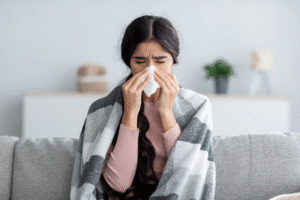
Reducing work-related illness with health surveillance
Employers can struggle to meet their legal duty to ensure employees exposed to certain health risks aren’t being made sick by work.
Hearing and vision loss, repetitive strain injuries, cancer, back pain and skin conditions are just some of the most common work-related illnesses.
Every year, 1.7 million employees develop work-related illnesses, with the HSE estimating that 12,000 a year are dying from work-related lung conditions alone.
Critical to ensuring your organisation isn’t making employees sick is identifying the potential risks and making sure employees attend the health checks needed to keep them safe.
Identifying the risks
It’s surprising how many organisations don’t realise their employees are being exposed to risks that they are legally required to protect them from. These can range from exposure to radiation found in research departments, to chemicals in food production, to noise and vibration on building sites.
Employers are legally required to maintain a safe workplace, so must carry out a risk assessment to identify any potential risks to employees. Where these risks are so hazardous that they pose a health risk, even after safety measures have been implemented, a programme of health surveillance must also be put in place.
Health risks requiring health surveillance, under the Health & Safety at Work Act, include hazardous substances, such as lead and asbestos, noise, vibration and night working. However, the risk assessment must also consider how often employees are exposed to these risks. If someone is only using an air-powered drill for five minutes a month, they are unlikely to need health surveillance.
It’s about understanding the risk to an individual, based on what they’re actually doing, rather than making assumptions about their risks based on their job description. If an employer lacks the understanding needed to assess risk, it’s important to get professional expertise.
Conducting health surveillance
Health surveillance consists of taking some baseline health measures for employees and repeating the checks at regular intervals, to identify any deterioration as soon as possible.
This enables employees to get timely access to treatment, to reduce the risk of long-term health issues, and enables employers to identify where safety measures aren’t working.
For instance, if employees in one part of the business are experiencing more hearing loss than employees in other areas, why is this? Is there a lack of protective equipment, or are employees not wearing it for some reason? Is there a culture of bravado or do employees just not understand the health risks or safety advice they’re meant to be following?
If it’s unclear what’s driving the increase in work-related ill health, an occupational health advisor (OHA) can be brought on-site to observe employees and make recommendations on what needs to change to reduce the health risk. Sometimes this can be around better educating employees and managers, other times the risk needs to be designed out, by changing processes and equipment, or better mitigated with protective measures.
Reducing non-compliance
Problems arise when employees feel perfectly fine, and haven’t noticed any symptoms, so don’t see the point in having another assessment. Or because they may be worried something might get found, meaning they won’t be allowed to do their job anymore and won’t get paid.
Managers can also be reluctant to release someone from the shop floor for testing because they see health surveillance as a pointless health and safety exercise or are worried someone might get taken off a project. This can result in a high level of ‘non-compliance’ leading to legal penalties and a reduction in the ability of the employer to sustain a safe workplace.
Critical to reducing non-compliance rates is ensuring managers are fully committed to ensuring all their team attends. Measures such as publishing internal league tables of departmental compliance rates can more than halve non-compliance rates.
Employees also need to be educated about the value of health surveillance to them personally and the consequences of not attending. Case studies from individuals, who have a reduced quality of life after developing health issues due to not attending their health surveillance checks, are a powerful way to do this.
Leading from the top
Changing the culture of the organisation, from one where health surveillance isn’t prioritised, also requires getting senior leaders on board.
This can be as simple as getting them to give a talk on why health surveillance matters, to getting them to back serious measures for non-compliance. For example, taking people off-site when they’ve missed more than one appointment, until they’ve been reassessed.
Leaders also need to be seen to be acting on the findings of health surveillance, by strengthening health and safety measures in areas where there are issues. This could range from redesigning equipment to introducing sanctions for not wearing PPE.
It’s also important for leaders to walk the shop floor and talk to employees and even try doing some of their roles to understand what the real issues are. If the current PPE means employees are struggling to handle tools or do their work, this needs to be understood and a solution put in place.
Automating the process
Sometimes employees can’t attend their health surveillance check for valid reasons. By using a flexible booking system, you can make it easy for employees to reschedule appointments to reduce wasted spend on poor attendance.
It can also be helpful to automate this process to send reminders and schedule appointments a couple of months before someone’s health record runs out. That way, if they need to reschedule, you still have enough time to get them checked.
An automated process can also track the employee’s health surveillance journey, from the moment they start work, to automatically schedule appointments to comply with statutory requirements.
This ensures that health surveillance checks aren’t accidentally overlooked and provides continuous reporting and oversight of compliance, so you can be sure that you are meeting your legal duty to protect the health of your workers.
Dr Bernard Yew is the medical director for PAM OH
Panel discussion: What’s the real purpose of health surveillance at work?
9.30am, Tuesday 21 October 2025
Join our clinical team and Alison Crawley, head of health at engineering firm EKFB, for a discussion about what health surveillance is (and isn’t) and how to make it effective.
How can PAM Group help?
We can help you to keep employees healthy in the following ways:
Occupational Health Assessments – clinical assessments to understand how someone’s condition is impacting their ability to work with recommendations for phased reasonable adjustments to help them return to work and gradually build up their duties.
Health Surveillance – managed health surveillance programmes to increase the number of people attending their appointments to help you meet your HSE legal obligations to maintain a safe workplace.
Fitness for work – pre-placement screening to identify any health risks and create a baseline for future health surveillance. We also offer safety critical medicals and alcohol and drugs testing to ensure employees are safe to perform their role.
To find out more, please visit pamgroup.co.uk or email info@pamgroup.co.uk
Related Insights
Flu season is coming early – is your workplace ready?
How to respond to the rise in employee drug and alcohol use
New data reveals hidden reasons employees struggle at work
Occupational health insights on keeping your people healthy and productive
Want to have our latest research, case studies and opinions
delivered straight to your inbox?






